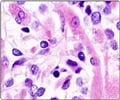Scientists at Scripps Research Institute have uncovered the structure of a protein that makes cancer cells resistant to chemotherapy.
Scientists at Scripps Research Institute have uncovered the structure of a protein that makes cancer cells resistant to chemotherapy.
The protein, called P-glycoprotein or P-gp makes cancer cells resistant to chemotherapy drugs. The research team believes that the structure would help them design more effective drugs."This structure is an important advance and we hope it is just the beginning of more breakthroughs for us," said the study's senior author Geoffrey Chang, an associate professor at Scripps Research.
"The structure is a nice tool for understanding how drugs are transported out of cells by P-gp and for designing drugs to evade P-gp preventing drug resistance. It's very exciting," he added.
"We've long known that P-glycoprotein plays a key role in multidrug resistance in cancer patients, and this work helps us understand how the protein can act on such a wide range of compounds," said Jean Chin, Ph.D., of the National Institutes of Health's (NIH) National Institute of General Medical Sciences (NIGMS).
During the study, the Scripps scientists along with colleagues from Texas Tech University Health Sciences Centre determined the structure of P-gp using a technique in structural biology known as x-ray crystallography, which involves making crystals of ordered arrays of protein and then blasting the frozen crystals with x-ray radiation.
"In the future, scientists may be able to use these crystal structures to design chemicals that block P-glycoprotein's activity and restore sensitivity to chemotherapeutic agents."
Advertisement
It is believed that P-gp works by bringing the two dumbbell-shaped arms together on the inside of the cell and opening the closed end toward the outside of the cell, essentially reversing direction of the "v" or tipi so any substance caught inside the protein's cavity is ejected from the cell.
Advertisement
Source-ANI
SRM














